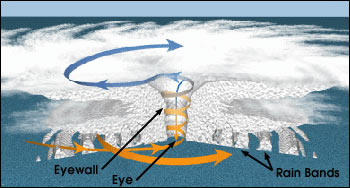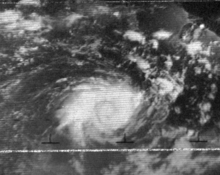Portal:Tropical cyclones
The Tropical Cyclones Portal

A tropical cyclone is a storm system characterized by a large low-pressure center, a closed low-level circulation and a spiral arrangement of numerous thunderstorms that produce strong winds and heavy rainfall. Tropical cyclones feed on the heat released when moist air rises, resulting in condensation of water vapor contained in the moist air. They are fueled by a different heat mechanism than other cyclonic windstorms such as Nor'easters, European windstorms and polar lows, leading to their classification as "warm core" storm systems. Most tropical cyclones originate in the doldrums, approximately ten degrees from the Equator.
The term "tropical" refers to both the geographic origin of these systems, which form almost exclusively in tropical regions of the globe, as well as to their formation in maritime tropical air masses. The term "cyclone" refers to such storms' cyclonic nature, with anticlockwise rotation in the Northern Hemisphere and clockwise rotation in the Southern Hemisphere. Depending on its location and intensity, a tropical cyclone may be referred to by names such as "hurricane", "typhoon", "tropical storm", "cyclonic storm", "tropical depression" or simply "cyclone".
Types of cyclone: 1. A "Typhoon" is a tropical cyclone located in the North-west Pacific Ocean which has the most cyclonic activity and storms occur year-round. 2. A "Hurricane" is also a tropical cyclone located at the North Atlantic Ocean or North-east Pacific Ocean which have an average storm activity and storms typically form between May 15 and November 30. 3. A "Cyclone" is a tropical cyclone that occurs in the South Pacific and Indian Oceans.
Selected named cyclone -
Severe Tropical Cyclone Tracy was a small tropical cyclone that devastated the city of Darwin, in the Northern Territory of Australia, in December 1974. The small, developing, easterly storm was originally expected to pass clear of the city, but it would turn towards it early on 24 December. After 10:00 p.m. ACST, damage became severe, with wind gusts reaching 217 km/h (117 kn; 135 mph) before instruments failed. The anemometer in Darwin Airport control tower had its needle bent in half by the strength of the gusts.
Residents of Darwin were celebrating Christmas, and they did not immediately acknowledge the emergency, partly because they had been alerted to an earlier cyclone (Selma) which passed west of the city, not affecting it in any way. Additionally, news outlets had only a skeleton crew on duty over the holiday. (Full article...)Selected article -
The effects of Hurricane Dean in the Lesser Antilles were spread over five island countries and included 3 fatalities. Hurricane Dean formed in the Atlantic Ocean west of Cape Verde on August 14, 2007. The National Hurricane Center's first Forecast Advisory on the system anticipated that the Cape Verde-type hurricane would pass into the Caribbean through the Lesser Antilles. The storm moved persistently towards the small island chain, strengthening until it passed through the islands three days later on August 17 as a Category 2 hurricane on the Saffir-Simpson Hurricane Scale. It went on to brush the island of Jamaica and reached Category 5 strength before making landfall on Mexico's Yucatán Peninsula.
While crossing the Lesser Antilles, Dean caused moderate damage in St. Lucia, Martinique, and Dominica, where it washed out roads, damaged houses, and killed 6 people. It also devastated the agriculture-dependent economies of those three states, as well as that of Guadeloupe, destroying between 80% and 100% of the banana crops. Deaths were reported as far away as Trinidad. (Full article...)Selected image -

Selected season -

The 1988 Pacific hurricane season was the least active Pacific hurricane season since 1981. It officially began May 15, in the eastern Pacific, and June 1, in the central Pacific and lasted until November 30. These dates conventionally delimit the period of each year when most tropical cyclones form in the northeastern Pacific Ocean. The first named storm, Tropical Storm Aletta, formed on June 16, and the last-named storm, Tropical Storm Miriam, was previously named Hurricane Joan in the Atlantic Ocean before crossing Central America and re-emerging in the eastern Pacific; Miriam continued westward and dissipated on November 2.
The season produced 23 tropical depressions, of which 15 attained tropical storm status. Seven storms reached hurricane status, three of which became major hurricanes. The strongest storm of the season, Hurricane Hector, formed on July 30 to the south of Mexico and reached peak winds of 145 mph (233 km/h)—Category 4 status—before dissipating over open waters on August 9; Hector was never a threat to land. Tropical Storm Gilma was the only cyclone in the season to make landfall, crossing the Hawaiian Islands, although there were numerous near-misses. Gilma's Hawaiian landfall was unusual, but not unprecedented. There were also two systems that successfully crossed over from the Atlantic: the aforementioned Joan / Miriam and Hurricane Debby, which became Tropical Depression Seventeen-E, making the 1988 season the first on record in which more than one tropical cyclone has crossed between the Atlantic and Pacific basins intact. Three systems caused deaths: Tropical Storm Aletta caused one death in southwestern Mexico, Hurricane Uleki caused two drownings off the coast of Oahu as it passed by the Hawaiian Islands, and Hurricane Kristy caused 21 deaths in the Mexican states of Oaxaca and Chipas. (Full article...)Related portals
Currently active tropical cyclones

Italicized basins are unofficial.
- North Atlantic (2024)
- No active systems
- East and Central Pacific (2024)
- No active systems
- West Pacific (2024)
- No active systems
- North Indian Ocean (2024)
- No active systems
- Mediterranean (2023–24)
- No active systems
- South-West Indian Ocean (2023–24)
- No active systems
- Australian region (2023–24)
- No active systems
- South Pacific (2023–24)
- No active systems
- South Atlantic (2023–24)
- No active systems
Last updated: 21:50, 2 June 2024 (UTC)
Tropical cyclone anniversaries

June 5
- 1890 - A cyclone struck northeastern Oman, killing 727 people from its floods.
- 2001 - Tropical Storm Allison (pictured) formed over the northern Gulf of Mexico and made landfall in Southeast Texas. Allison caused record levels of rainfall along much of its path, with the resulting flooding killing 41 people and causing US$5.5 billion of damage, making Allison the costliest tropical storm on record.
- 2003 - Cyclone Epi developed east of Papua New Guinea.

June 6
- 1994 - Tropical Storm Russ moved across Hainan Island and southern China, killing 72 people and leaving US$727.5&bsp;million in damage.
- 1999 - Typhoon Maggie made landfall in China, and along its path the storm killed nine people.
- 2012 - Tropical Storm Kuena (pictured) became a rare June tropical storm in the South-West Indian Ocean.

June 7,
- 1973 - Hurricane Ava reached its peak intensity as a Category 5 hurricane, becoming the only Pacific hurricane to attain that intensity in the month of June.
- 2003 - Cyclone Gina (pictured) reaches its peak intensity as a Category 3 severe tropical cyclone after affecting the Solomon Islands with only minimal damages.
Did you know…




- …that the Joint Typhoon Warning Center considers that Typhoon Vera (pictured) of 1986 is actually two distinct systems, formed from two separated low-level circulations?
- …that Hurricane Agatha (pictured) was the strongest Pacific hurricane to make landfall in Mexico in May since records began in 1949?
- …that Cyclone Raquel (track pictured) travelled between the Australian and South Pacific basins between the 2014–15 and 2015–16 seasons, spanning both seasons in both basins?
- …that Cyclone Amphan (pictured) in 2020 was the first storm to be classified as a Super Cyclonic Storm in the Bay of Bengal since 1999?
General images -
As Hurricane Isaias moved up the East Coast of the United States, a damaging outbreak of 39 tornadoes impacted areas from South Carolina to Connecticut between August 3–4, 2020. The most significant tornado of the outbreak was a large and intense EF3 tornado that obliterated a mobile home park near Windsor, North Carolina, killing two and injuring 14. This was the strongest tornado in the United States to be spawned by a tropical cyclone since 2005. In the end, the outbreak killed two and injured 26. (Full article...)
Topics
Subcategories
Related WikiProjects
WikiProject Tropical cyclones is the central point of coordination for Wikipedia's coverage of tropical cyclones. Feel free to help!
WikiProject Weather is the main center point of coordination for Wikipedia's coverage of meteorology in general, and the parent project of WikiProject Tropical cyclones. Three other branches of WikiProject Weather in particular share significant overlaps with WikiProject Tropical cyclones:
- The Non-tropical storms task force coordinates most of Wikipedia's coverage on extratropical cyclones, which tropical cyclones often transition into near the end of their lifespan.
- The Floods task force takes on the scope of flooding events all over the world, with rainfall from tropical cyclones a significant factor in many of them.
- WikiProject Severe weather documents the effects of extreme weather such as tornadoes, which landfalling tropical cyclones can produce.
Things you can do
 |
Here are some tasks awaiting attention:
|
Wikimedia
The following Wikimedia Foundation sister projects provide more on this subject:
-
Commons
Free media repository -
Wikibooks
Free textbooks and manuals -
Wikidata
Free knowledge base -
Wikinews
Free-content news -
Wikiquote
Collection of quotations -
Wikisource
Free-content library -
Wikiversity
Free learning tools -
Wikivoyage
Free travel guide -
Wiktionary
Dictionary and thesaurus

























































